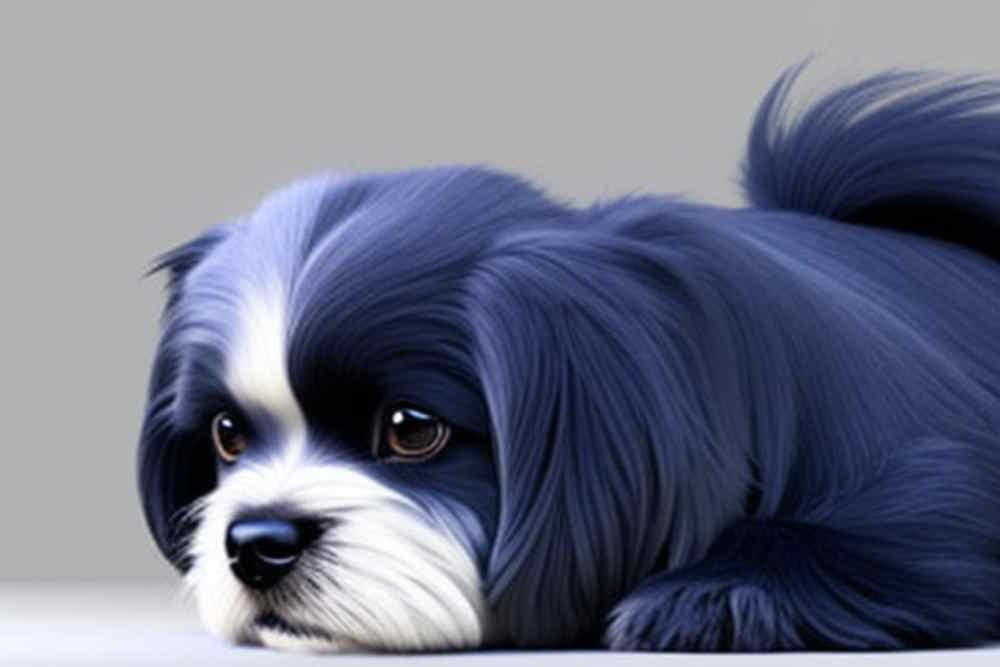- Home
- colors & markings
- blue dog
All About The Blue Shih Tzu: A Comprehensive Guide To This Rare Breed
Have you ever heard of a blue Shih Tzu?
 Computer generated image of a blue Shih Tzu dog
Computer generated image of a blue Shih Tzu dogSpoiler alert: they're not actually blue, and it's not referring to their coat color but more so their skin.
This particular furry friend is an underrated fixture in the Shih Tzu community.
But, while they might not be as talked about as others in the breed, it doesn't make them any less adorable.
Want to learn even more about these stunning blue pups...then keep reading!
What is a Blue Shih Tzu
A "blue Shih Tzu" is a term used to describe the pigmentation of a Shih Tzu breed of dog. This term refers to a genetic variation that results in a blue-black color in the dog's nose, lips and eye rims.
The difference between a blue Shih Tzu and, say, a gold Shih Tzu is that they are named not by the color of their coat but due to the pigment of their skin.
Similar to liver Shih Tzu's, these pups are determined to be blue based on how certain body parts look.
Excluding their liver counterparts, all other Shih Tzus besides the blue Shih Tzu have black noses, eye rims, and paw pads.
In liver dogs, these body parts have a brown hue, but in blue ones, they give off a diluted bluish hue that is harder to see than the liver Shih Tzu's.
Whereas "blue" refers to the Shih Tzu's skin and not their coat color, these pups can be any color or combination of the breed but are typically shades of gray or a lighter-toned black.
According to the American Kennel Club's breed standard, two standard colors are officially recognized among blue Shih Tzu, and these colors are blue and blue and white.
This does not mean they can't have other colors, as the AKC acknowledges all colors among the Shih Tzu breed.
However, when it comes to their eyes, the blue Shih Tzu's eyes are a lighter shade than the other kinds of Shih Tzus, which are typically dark brown.
While the American Kennel Club does not specify what lighter shade they come in, it may range from an amber brown to possibly a hazel color.
Are Blue Shih Tzu Rare?

Blue Shih Tzu's are definitely not the norm when it comes to Shih Tzus. They are the product of a diluted recessive gene, which makes them less likely to be produced in a litter.
As a result, blue Shih Tzu is not as common as other types of Shih Tzu, but there is a higher chance that you'll come across a blue Shih Tzu than one with a solid color coat.
Another reason they may be considered rare is that their skin tone is the product of a diluted black.
So, at first glance, it may seem like you are looking at a regular Shih Tzu.
However, you may have to get up close and personal, in natural light, to see that distinct blue hue on their skin.
How Blue Shih Tzu Differ From Black Shih Tzu
The blue Shih Tzu is similar to black in that their skin tone is a diluted form of black.
But, a very distinct difference between a black Shih Tzu and a blue one is that a black Shih Tzu is categorized by the color of its coat, not skin.
So, a blue Shih Tzu can be black, but a black Shih Tzu is not always considered a blue one.
A little confusing, but that's the beauty of the Blue Shih Tzu, and it does an excellent job of being unique in a breed that is known for its special qualities.
In comparison, blue Shih Tzu's are a paler shade of black and come across as a silvery greyish tone.
Another difference between the two is that while a black Shih Tzu's color can fade into a lighter shade of black, blue Shih Tzu are born that way and will always have that distinguishable appearance to their noses and other body parts.
In dogs that have a mutation that results in the "blue" appearance, they tend to have amber-colored eyes, whereas the traditional Shih Tzu, without this mutation, has dark brown eyes.
Genetics Behind the Blue Shih Tzu

Who knew that a pup as majestic and mesmerizing as the Blue Shih Tzu could owe its stunning hue to some good ole fashioned genetics?
A lesson in biology proves these pups are so much more than their cuddly appearances!
Blue Shih Tzu are the result of a genetic mutation within part of the DNA that hosts the D locus. It is connected with the MLPH gene, which is responsible for a dog's color coat.
In simpler terms, the D locus represents the black pigment, and when this is disrupted, the MLPH gene is affected, which is what makes the Shih Tzu blue!
For a Shih Tzu to be blue, both parents have to be carriers of the gene, meaning that they can be a traditional Shih Tzu but can pass on the blue trait to their offspring.
Both alleles have to be recessive for a puppy to be born and considered blue.
The alleles for a blue dog are represented by two lowercase d's (d/d), the lowercase d representing the gene for a blue dog.
If two parents are (D/D), this means that the puppy will not be considered blue. The capital D's represent the non-blue gene.
If both parents are d/d, the dog will have the definite dilute gene, and lastly, if both parents are D/d, while they are not a blue Shih Tzu, there is a 50% chance that their puppy will come out as a blue Shih Tzu.
An interesting fact about the blue Shih Tzu is that those who have a mutated D locus are also more susceptible to developing alopecia, which is essentially hair loss that can occur in dogs.
Therefore, knowing about the genetics of a blue Shih Tzu is important not only when it comes to understanding why they are blue but also to understand why these types of Shih Tzu are rare.
In conclusion, although many people may not be as familiar with the blue Shih Tzu compared to others of the same breed or famous blue dogs, such as the Australian Sheperd, they are just as adorable and cute.
These dogs make great companions and are sure to stop people in their tracks.
This Shih Tzu is distinguished by the blue hue of its skin and is one of two in the breed that is characterized by its skin tone and not the color of its coat.
The easiest way to tell whether you have a blue Shih Tzu is to look at their nose, eye rims, or paw pads.
You'll be sure to see the notable shade that makes it so unique. Its blue pigment makes these types of Shih Tzu rare and a hot commodity for those who love the look of a blue dog.
While the color of the Shih Tzu is not an actual blue color as we might know it, its paler shade makes it different than its darker black tone counterpart.
While other Shih Tzu colors may fade or change over time, this specific pup will always have that exceptional blue pizzaz only it can have.
- Home
- colors & markings
- blue dog
